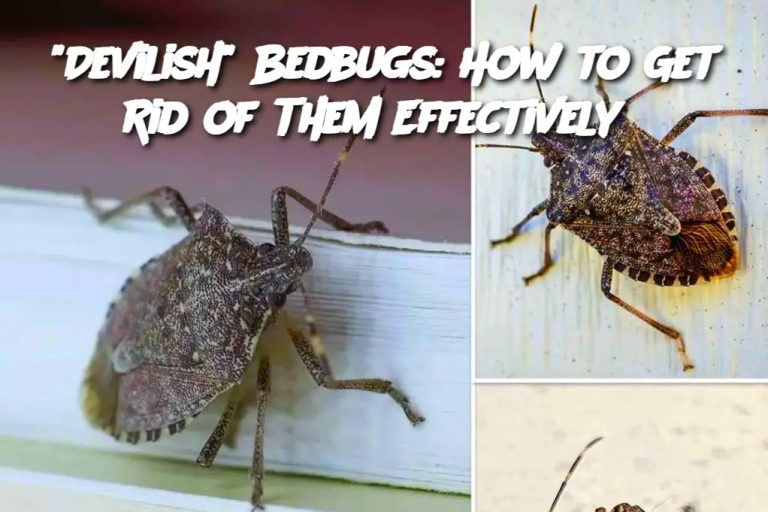ADVERTISEMENT
Introduction:
Bedbugs are notoriously difficult pests to deal with, and their presence in your home can be both frustrating and unsettling. These tiny, blood-sucking insects can hide in the smallest crevices and thrive in the most unlikely places, making them tricky to spot and eliminate. The term "Devilish" bedbugs highlights their cunning ability to go undetected, often causing severe itching, rashes, and sleepless nights for anyone unfortunate enough to be bitten. However, getting rid of them effectively is possible with a strategic approach. In this article, we’ll guide you through how to identify, prevent, and eliminate bedbugs once and for all.
Ingredients (Tools & Materials You’ll Need):
Steam Cleaner: Bedbugs can’t survive extreme heat, so a high-temperature steam cleaner is a must for killing both bedbugs and their eggs.
Bedbug Mattress Encasements: Special covers that completely encase your mattress and box spring, making it impossible for bedbugs to infest.
Pesticides (if needed): If infestation is severe, choose a bedbug-specific pesticide or consult a professional exterminator.
Vacuum Cleaner: A vacuum with a HEPA filter can help capture and remove bedbugs, eggs, and larvae from carpets and cracks in furniture.
Alcohol (Isopropyl): A spray bottle of rubbing alcohol can help kill bedbugs on contact when sprayed directly.
Diatomaceous Earth: This powdery substance is a natural way to kill bedbugs by dehydrating them.
Flashlight: To inspect cracks, seams, and crevices where bedbugs might hide.
Instructions:
Identify the Infestation: The first step in dealing with bedbugs is confirming their presence. Look for signs such as small, dark spots of bedbug feces, reddish-brown stains from crushed bedbugs, or shed skin. Check the seams of your mattress, behind headboards, and in cracks along the walls and floor.
Vacuum Thoroughly: Once you've identified infested areas, vacuum every crack, corner, and seam where bedbugs may be hiding. Use a vacuum with a HEPA filter to ensure you trap any bugs, eggs, and larvae effectively. Dispose of the vacuum bag in a sealed plastic bag right after cleaning.
Treat with Heat: Bedbugs cannot survive temperatures above 113°F (45°C). Use a steam cleaner to treat your mattress, furniture, and floors. Steam is an effective and eco-friendly way to kill bedbugs and their eggs. Make sure to treat both the visible and hidden areas.
Apply Diatomaceous Earth: Sprinkle diatomaceous earth in the cracks of walls, floors, and around your bed. This natural powder will dehydrate and kill bedbugs over time. Leave it for a few days, then vacuum it up.
Encase Your Mattress: Install bedbug-proof encasements on your mattress and box spring to trap any remaining bedbugs and prevent new ones from entering. These encasements should remain on for at least a year to ensure all bugs trapped inside die off.
Use Alcohol for Spot Treatment: For immediate relief, spray rubbing alcohol directly onto bedbugs or their hiding spots. Alcohol kills them on contact and can be a quick fix for localized areas of the infestation.
Pesticides (if necessary): If you have a serious infestation that doesn’t respond to DIY treatments, consider using a pesticide specifically labeled for bedbug control. Follow the instructions carefully or hire a professional pest control service to handle the issue.
Monitor and Repeat Treatments: Even after taking these steps, it’s essential to monitor for any new signs of bedbug activity. Continue treating your home with heat and other methods regularly until you're confident the infestation is gone.
Serving and Storage Tips:
Prevention is Key: After successfully getting rid of bedbugs, continue monitoring your home. Regularly inspect your bedding, furniture, and any new or secondhand items you bring into your home.
Store Items in Sealed Bags: If you're storing clothes or bedding for an extended period, make sure they're placed in sealed plastic bags to prevent re-infestation.
Maintain Mattress Encasements: Keep mattress and box spring encasements in place for ongoing protection. These are a proactive measure to prevent any new bedbugs from setting up shop.
Variations:
ADVERTISEMENT
